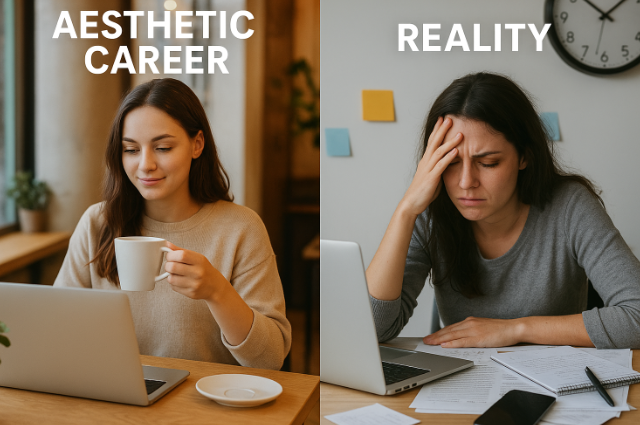
There’s a strange shift happening in the way young people choose careers today. It’s not purely about money, security or even passion anymore. It’s about how a job looks. Not the work itself, but the visual identity that comes with it, the soft-lit desk setups, the perfect café laptops, the slow mornings, the framed productivity, the minimalist lifestyle that feels less like reality and more like a curated moodboard. For a generation raised online, careers are no longer just professions. They’re aesthetics.
Somewhere along the way, “doing what you love” slowly turned into “doing what looks good when posted.” And that’s where the distortion begins. People look at content creators, independent designers, therapists, digital marketers, writers, consultants and think these roles come with effortless mornings and stable emotional energy. What they don’t see is everything that falls outside the frame.
I’ve noticed this first-hand in conversations with friends who left stable jobs to pursue something more “aligned with their vibe.” One friend quit her well-paying role because she felt disconnected from the version of herself she imagined online: the girl with a peaceful schedule, a neatly arranged desk, a cup of herbal tea and a job that didn’t demand sudden deadlines. The reality hit her later: even creative careers come with stress, financial uncertainty and long hours. The aesthetic of freedom was real, but the freedom wasn’t.
Social media plays a major role in shaping these illusions. Every niche now has a “look”: the soft-girl therapist aesthetic, the neutral-toned marketing consultant aesthetic, the cafe working copywriter, the design student with a perfectly messy workspace. The way these jobs are portrayed isn’t wrong; it’s just incomplete. It shows you beauty without the burnout, flexibility without the hustle, creativity without the instability. It’s a highlight reel that becomes a blueprint for people making actual life decisions.
This isn’t about blaming individuals. It’s about understanding how content reshapes desire. When you see the same careers romanticised thousands of times, it slowly enters your subconscious: this is what a fulfilling life looks like. It makes conventional jobs feel boring, even if they’re stable and meaningful. It makes slow growth feel like failure. It makes realistic choices feel like settling.
The irony is that even the people romanticising their careers don’t live the life they portray. A content creator may post a calm morning routine but spend the afternoon stressing about brand deals. A freelancer may upload an aesthetic desk picture minutes before handling a difficult client. A remote worker might look peaceful online but struggle with isolation offline. The divide between the aesthetic and the actual is wide, but social media collapses the two into one.
What makes this trend more complex is the emotional pressure it creates. Young people today want purpose and alignment, but they’re also told to chase what looks meaningful. It creates a subtle anxiety if your job doesn’t photograph well; is it even valuable? If your routine doesn’t feel peaceful, are you doing something wrong? If your career doesn’t match your Pinterest board, are you in the wrong field? People are not just comparing incomes anymore; they’re comparing lifestyles, rhythms, aesthetics and identities.
Of course, there’s nothing wrong with wanting beauty in your work life. It’s human to want a job that feels inspiring. The real danger lies in confusing the visual version of a career with the lived version. Aesthetic-driven choices can sometimes lead people into roles that don’t match their strengths or needs. Someone drawn to the calm vibe of being a therapist may not be prepared for the emotional heaviness. Someone who chooses freelancing for the flexibility might not enjoy the unpredictability. Someone who romanticises writing may not enjoy the loneliness it comes with.
Another unnoticed consequence is the shame that arises when the real job doesn’t match the imagined one. I’ve seen people switch careers only to feel guilty when the process becomes messy, chaotic or mentally exhausting. They blame themselves instead of recognising that no career, no matter how beautiful, comes without friction. Aesthetic careers are still careers. They demand consistency, resilience and skill development, not just a curated lifestyle.
Yet, this entire movement reveals something important about this generation: they crave a life they feel connected to. They want work that doesn’t drain them. They want autonomy, creativity, meaning and softness in their days. The desire isn't the problem; it’s the filter through which they’re seeing work.
There’s a healthier way to approach it. Instead of choosing a career because it looks good online, choose one that aligns with your temperament. Instead of chasing the aesthetic of freedom, chase skills that give you freedom. Instead of building a life that photographs well, build a life that feels steady even when no one is watching. Aesthetic inspiration can be a starting point, but it shouldn’t be the destination.
In the end, the question isn’t whether aesthetic careers are good or bad. It’s whether we are choosing our paths with honesty. A beautiful life is worth pursuing. Everyone deserves work that feels meaningful, freeing, and emotionally aligned. But a life can only stay beautiful if its foundation is real. The laptop shots, the clean workspaces, the soft-hour routines, those are just the surface. What you build underneath, the part no one sees, is what keeps you standing.
Maybe the real maturity of this generation is learning to balance both:
to dream aesthetically but commit realistically; to choose careers that photograph well but also feel right on the days when nothing looks aesthetic; to build a life that isn’t just appealing to the world, but sustainable within the heart; Because in the long run, it’s not the aesthetic of the career that saves you; It’s the truth of it.
References:
- https://hbr.org
- https://www.weforum.org
- https://www.pewresearch.org
- https://www.mckinsey.com
- https://www.forbes.com
